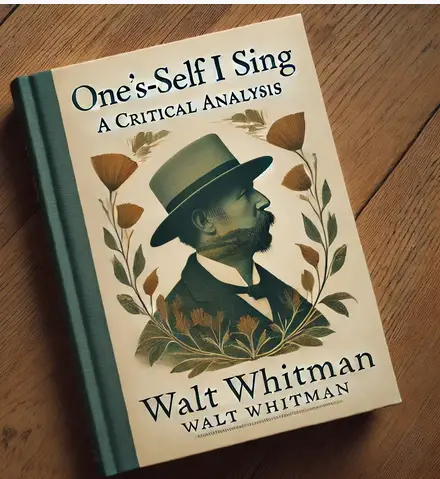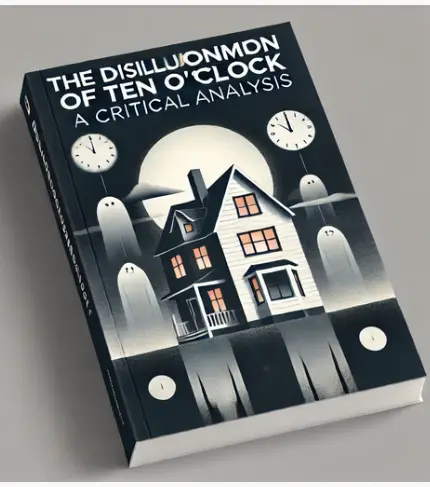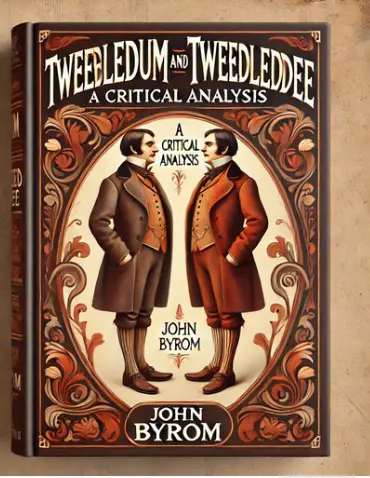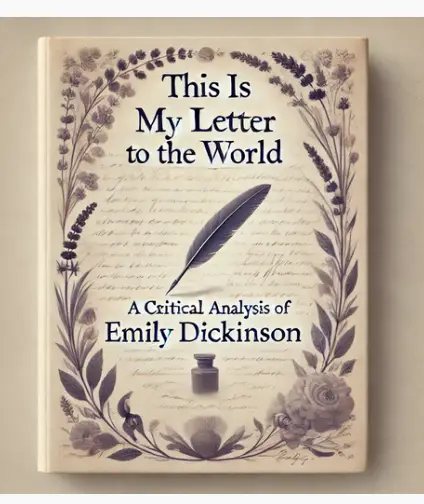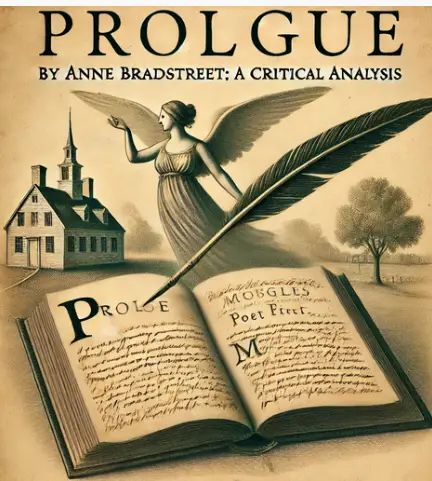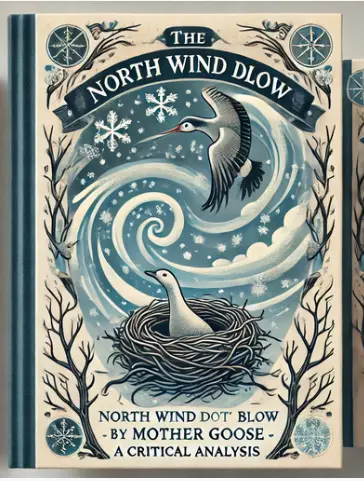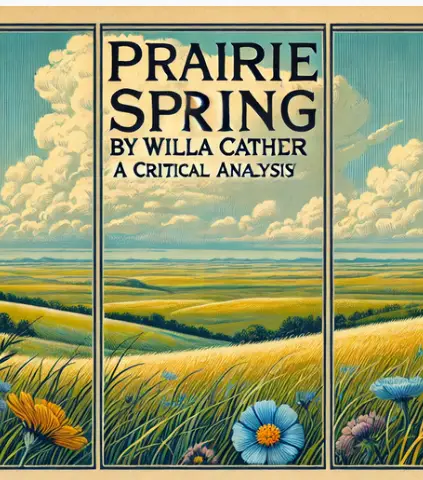
Introduction: “Prairie Spring” by Willa Cather
“Prairie Spring” by Willa Cather first appeared in her 1913 collection O Pioneers!, a novel that is part of her Great Plains Trilogy. This poem serves as a prelude to the novel, capturing the expansive and vivid landscape of the American Midwest, which plays a central role in the novel itself. The poem’s main qualities include its lyrical celebration of nature and the seasons, especially spring, which Cather presents as a time of renewal and energy. Through rich imagery, “Prairie Spring” conveys the main idea of the resilience and beauty of the land, as well as the emotional connection people have to their environment. It reflects Cather’s broader theme of the human struggle with and against the untamed forces of nature.
Text: “Prairie Spring” by Willa Cather
Evening and the flat land,
Rich and sombre and always silent;
The miles of fresh-plowed soil,
Heavy and black, full of strength and harshness;
The growing wheat, the growing weeds,
The toiling horses, the tired men;
The long empty roads,
Sullen fires of sunset, fading,
The eternal, unresponsive sky.
Against all this, Youth,
Flaming like the wild roses,
Singing like the larks over the plowed fields,
Flashing like a star out of the twilight;
Youth with its insupportable sweetness,
Its fierce necessity,
Its sharp desire,
Singing and singing,
Out of the lips of silence,
Out of the earthy dusk.
Annotations: “Prairie Spring” by Willa Cather
| Line | Annotation | Structural Devices | Poetic Devices | Literary & Rhetorical Devices |
| Evening and the flat land, | Introduces the setting: vast, flat land at evening, creating a sense of stillness and openness. | Opening line, simple structure | Imagery (visual), Diction (calm, neutral tone), Setting | |
| Rich and sombre and always silent; | Describes the land as fertile yet melancholic and quiet, emphasizing its constant stillness. | Polysyndeton (repeated “and”) | Imagery (auditory and visual), Mood (melancholy) | |
| The miles of fresh-plowed soil, | Highlights the landscape as expansive and productive, recently tilled for planting. | Enjambment into the next line | Imagery (visual), Symbolism (fertility, renewal) | |
| Heavy and black, full of strength and harshness; | Describes the soil as dense and full of potential, yet tough and unforgiving. | Enjambment | Contrast: “strength” vs. “harshness” | Imagery (tactile and visual), Diction (weighty, oppressive) |
| The growing wheat, the growing weeds, | Focuses on the life emerging from the soil, both crops and weeds, suggesting growth and competition. | Parallel structure (repetition of “the growing”) | Repetition: “growing” | Symbolism (wheat: growth, life; weeds: struggle, opposition) |
| The toiling horses, the tired men; | Depicts labor on the land, highlighting the exhaustion of both animals and humans. | Parallelism | Alliteration: “toiling,” “tired” | Imagery (kinesthetic), Diction (exhaustion), Human-nature relationship |
| The long empty roads, | Suggests isolation and vastness, roads leading nowhere in the empty landscape. | Simple structure | Imagery (spatial), Symbolism (emptiness, solitude) | |
| Sullen fires of sunset, fading, | The setting sun is described as angry and dimming, reflecting the end of a day’s labor. | Enjambment | Personification: “sullen fires” | Imagery (visual), Mood (somber), Time passage |
| The eternal, unresponsive sky. | The sky is vast and indifferent, suggesting nature’s lack of concern for human toil. | End-stopped | Personification: “unresponsive” | Imagery (visual), Symbolism (nature’s indifference) |
| Against all this, Youth, | Introduces youth as a contrasting force to the stillness and harshness of the land. | Transitional phrase | Contrast: “youth” vs. “all this” | Juxtaposition (youth vs. landscape), Theme (youth vs. nature) |
| Flaming like the wild roses, | Youth is compared to wild roses, symbolizing passion and untamed beauty. | Simile | Simile: “like the wild roses” | Imagery (visual, symbolic), Symbolism (wild roses: beauty, vitality) |
| Singing like the larks over the plowed fields, | Youth is full of joy and energy, likened to birds singing over the fields. | Simile, Enjambment | Simile: “like the larks” | Imagery (auditory, visual), Symbolism (larks: joy, freedom) |
| Flashing like a star out of the twilight; | Youth is bright and fleeting, like a star briefly visible at twilight. | Simile, Enjambment | Simile: “like a star” | Imagery (visual), Symbolism (star: brilliance, fleeting nature) |
| Youth with its insupportable sweetness, | Youth is described as sweet yet overwhelming, suggesting both beauty and intensity. | Inverted sentence structure | Oxymoron: “insupportable sweetness” | Tone (intense, passionate), Paradox (youth’s beauty and burden) |
| Its fierce necessity, | Youth is portrayed as driven by strong, urgent desires. | Parallelism | Diction (fierce, necessity), Theme (youth’s drive) | |
| Its sharp desire, | Youth is marked by a piercing and intense longing. | Parallelism | Diction (sharp), Theme (desire, ambition) | |
| Singing and singing, | Repetition emphasizes youth’s persistent energy and joy. | Repetition (singing) | Repetition (emphasizes action) | Imagery (auditory), Tone (joyful, exuberant) |
| Out of the lips of silence, | Youth breaks the silence of the landscape with its song, symbolizing life and vitality. | Inversion | Personification: “lips of silence” | Imagery (auditory), Symbolism (breaking silence) |
| Out of the earthy dusk. | Youth emerges from the dimness of the land, suggesting a connection between life and the earth. | End-stopped | Contrast: “earthy” vs. “youth” | Imagery (visual), Symbolism (dusk: transition, end of day) |
Literary And Poetic Devices: “Prairie Spring” by Willa Cather
| Device | Example | Explanation |
| Assonance | “Rich and sombre and always silent” | The repeated vowel sound “o” in “sombre” and “always” creates a melodic quality, reinforcing the mood of melancholy. |
| Contrast | “Rich and sombre” | Juxtaposition of “rich” and “sombre” to show the dual nature of the landscape, both fertile and bleak. |
| Enjambment | “Sullen fires of sunset, fading, / The eternal, unresponsive sky.” | The thought continues over two lines without a pause, emphasizing the endless and indifferent sky. |
| Hyperbole | “Eternal, unresponsive sky” | Exaggerates the vastness and indifference of the sky to emphasize its distance from human concerns. |
| Imagery | “Flaming like the wild roses” | Vivid visual imagery is used to evoke the bright, passionate nature of youth. |
| Juxtaposition | “Against all this, Youth” | Places the harshness of the landscape in opposition to the vitality of youth, highlighting the contrast between them. |
| Metaphor | “Out of the lips of silence” | Silence is personified as having “lips,” suggesting that youth breaks the quiet of the landscape. |
| Mood | “Sullen fires of sunset, fading” | The choice of words like “sullen” and “fading” creates a melancholic and reflective mood. |
| Onomatopoeia | “Singing and singing” | The word “singing” mimics the sound of youth’s song, adding auditory imagery. |
| Oxymoron | “Insupportable sweetness” | Combines contradictory terms to show the overwhelming beauty and intensity of youth. |
| Parallelism | “The toiling horses, the tired men” | Repetition of similar sentence structures emphasizes the shared exhaustion of men and animals. |
| Personification | “The eternal, unresponsive sky” | The sky is given human traits of being “unresponsive,” emphasizing nature’s indifference. |
| Polysyndeton | “Rich and sombre and always silent” | The repeated use of “and” slows the pace, emphasizing the weight of the description. |
| Repetition | “Singing and singing” | Repetition of the word “singing” emphasizes the continuous energy and joy of youth. |
| Simile | “Flaming like the wild roses” | Youth is compared to wild roses, highlighting its vibrant and untamed nature. |
| Symbolism | “The long empty roads” | Represents isolation and the endlessness of life’s journey, symbolizing both opportunity and loneliness. |
| Tone | “Flaming like the wild roses” | The passionate and energetic tone of this line contrasts with the melancholic tone of the earlier lines, reflecting the shift to the theme of youth. |
| Visual Imagery | “Miles of fresh-plowed soil” | Provides a vivid picture of the landscape, making the reader visualize the vastness and fertility of the land. |
Themes: “Prairie Spring” by Willa Cather
- Nature’s Indifference: In “Prairie Spring,” Willa Cather explores the theme of nature’s indifference to human toil and existence. The landscape is described as vast, “rich and sombre and always silent,” with “the eternal, unresponsive sky” towering above. These descriptions convey a sense of detachment, suggesting that nature, while fertile and full of potential, remains indifferent to the struggles of the humans and animals that work the land. The soil is “heavy and black, full of strength and harshness,” emphasizing that while it can support life, it is also unyielding and unforgiving. This highlights the theme that nature exists on its own terms, unconcerned with human efforts or emotions.
- Human Struggle and Labor: The poem vividly portrays the relentless labor required to survive and thrive in such a harsh environment. The lines “The toiling horses, the tired men” emphasize the physical exhaustion shared by both man and animal in their struggle to cultivate the land. The “fresh-plowed soil” represents hard-earned progress, but it is accompanied by “harshness” and “strength,” indicating that this labor is grueling. This theme reflects the broader experience of settlers in the American Midwest, where life was defined by the constant battle against the land’s harshness and the need to carve out a livelihood through persistent hard work.
- Youth and Vitality: In contrast to the harsh and silent landscape, Cather introduces youth as a force of life and energy. The lines “Youth, flaming like the wild roses, singing like the larks” create a vivid image of vitality, with the youth being full of passion and energy. This theme celebrates the beauty and power of youth, which stands out against the quiet, indifferent land. Described as “flashing like a star out of the twilight,” youth is portrayed as brief yet brilliant, full of “insupportable sweetness” and “sharp desire.” The contrast between youth and the land suggests that while nature endures, human youth is fleeting but intensely vibrant.
- The Cycle of Life: The poem also reflects on the cyclical nature of life, where growth and renewal happen alongside toil and exhaustion. The “growing wheat, the growing weeds” symbolize both life’s potential and its inherent struggles, where fertile crops grow alongside obstacles like weeds. The imagery of “fresh-plowed soil” and “earthy dusk” suggests the beginning and end of cycles—the soil ready for new planting as the day fades into night. The cyclical theme is further reinforced by the contrast between the eternal sky and the fleeting nature of youth, hinting at the inevitability of aging and the enduring presence of the land long after human vitality fades.
Literary Theories and “Prairie Spring” by Willa Cather
| Literary Theory | Application to “Prairie Spring” | References from the Poem |
| Ecocriticism | Ecocriticism focuses on the relationship between humans and the natural world, often analyzing how nature is depicted in literature. In “Prairie Spring,” the landscape is presented as indifferent and harsh, reinforcing the idea that nature is not a passive backdrop but a force that shapes human existence. The poem highlights the toil and struggle of humanity against this vast, unresponsive environment. | “The eternal, unresponsive sky” and “The miles of fresh-plowed soil, heavy and black, full of strength and harshness” emphasize nature’s indifference and power over humans. |
| Modernism | Modernism often explores themes of alienation, disillusionment, and the fragmentation of human experience. Cather’s “Prairie Spring” reflects these themes by contrasting the endless, unyielding landscape with the fleeting, intense experiences of youth. The isolation and struggle against an indifferent nature suggest a modernist critique of humanity’s place in the world. | “The long empty roads, sullen fires of sunset, fading” suggests feelings of alienation, while “Youth… singing like the larks” captures a fleeting, passionate experience in contrast to the eternal landscape. |
| Regionalism | Regionalism emphasizes the specific characteristics of a geographical setting, often highlighting how the environment shapes the people who live there. Cather’s poem is deeply rooted in the landscape of the American Midwest, depicting its vastness, harshness, and beauty. The regional characteristics of the prairie—its isolation, the hard work required to cultivate it—define the experiences of the characters, particularly the laborers and youth. | “The toiling horses, the tired men” reflects the hard, labor-intensive life of the Midwestern farmers, while “Rich and sombre and always silent” captures the distinct atmosphere of the prairie landscape. |
Critical Questions about “Prairie Spring” by Willa Cather
- How does Willa Cather depict the relationship between humans and nature in “Prairie Spring”?
- In “Prairie Spring,” Willa Cather portrays nature as both a provider and a relentless force, one that humans must contend with in their daily lives. The imagery of “The miles of fresh-plowed soil, heavy and black, full of strength and harshness” suggests that while the land offers the potential for growth and prosperity, it demands immense effort and resilience from the people who work it. Nature is depicted as indifferent to human toil, reflected in the “eternal, unresponsive sky.” This highlights a complex relationship where humans are part of nature but are also at its mercy, constantly struggling to extract sustenance from the unforgiving land.
- What role does youth play in contrast to the landscape in “Prairie Spring”?
- Youth is presented as a vibrant, fleeting force that contrasts sharply with the eternal and indifferent landscape in “Prairie Spring.” The lines “Youth, flaming like the wild roses, singing like the larks” capture the energy, passion, and beauty of youth, which stands out against the static, silent land. While the prairie is described as “silent” and “sombre,” youth is “singing” and “flaming,” bringing a sense of vitality and life to an otherwise bleak environment. This contrast suggests that while the land endures unchanged, human experiences—especially those of youth—are brief but intense, filled with desire and exuberance.
- What imagery does Cather use to convey the harshness of life on the prairie in “Prairie Spring”?
- In “Prairie Spring,” Willa Cather employs vivid imagery to depict the tough, relentless life on the prairie. Descriptions like “The toiling horses, the tired men” highlight the physical exhaustion that comes with farming the land. The soil is “heavy and black, full of strength and harshness,” further emphasizing the difficulty of working in such an environment. Additionally, the “long empty roads” and “sullen fires of sunset, fading” create a mood of isolation and weariness, reflecting the emotional and physical toll the prairie demands from those who live there.
- How does Cather convey the fleeting nature of youth in “Prairie Spring”?
- In “Prairie Spring,” youth is depicted as a transient, almost ephemeral force that stands in contrast to the eternal landscape. The lines “Flaming like the wild roses, singing like the larks over the plowed fields” symbolize the brightness and vitality of youth, but this liveliness is framed within the setting sun and the approaching “earthy dusk.” The metaphor “Flashing like a star out of the twilight” reinforces the idea that youth, like a star at twilight, is a brief moment of brilliance before it fades into the inevitability of night. This imagery suggests that while nature is enduring, youth is marked by both its beauty and its impermanence.
Literary Works Similar to “Prairie Spring” by Willa Cather
- “Stopping by Woods on a Snowy Evening” by Robert Frost
Similar to “Prairie Spring,” this poem explores the relationship between humans and nature, emphasizing nature’s beauty and the quiet, indifferent forces of the natural world. - “To a Mouse” by Robert Burns
Both poems highlight human toil and the unpredictable, often harsh forces of nature, reflecting the vulnerability of humans working the land. - “The Darkling Thrush” by Thomas Hardy
Like “Prairie Spring,” this poem contrasts the bleakness of the natural landscape with a symbol of hope and renewal, represented by the thrush’s song and youth in Cather’s work. - “The Windhover” by Gerard Manley Hopkins
This poem, like “Prairie Spring,” uses vivid imagery and symbolism to explore the vitality of life in contrast to the vastness and power of the natural world. - “God’s Grandeur” by Gerard Manley Hopkins
Similar to “Prairie Spring,” this poem focuses on the tension between human industry and the enduring beauty and strength of the natural world.
Representative Quotations of “Prairie Spring” by Willa Cather
| Quotation | Context | Theoretical Perspective |
| “Evening and the flat land,” | Opening line setting the tone of the poem, describing the vastness and openness of the prairie landscape. | Ecocriticism: Emphasizes the environment as a significant force in shaping human experience. |
| “Rich and sombre and always silent;” | Describes the prairie land as fertile yet melancholic, reinforcing nature’s silent power. | Modernism: Reflects the isolation and emotional alienation associated with modernist themes. |
| “The miles of fresh-plowed soil,” | Highlights the hard work involved in farming the land, portraying the vastness of the landscape. | Regionalism: Captures the specific characteristics of the American Midwest. |
| “Heavy and black, full of strength and harshness;” | The soil is depicted as both powerful and unforgiving, representing the difficult relationship between man and nature. | Naturalism: Emphasizes nature’s dominance over human effort, reflecting harsh realities. |
| “The growing wheat, the growing weeds,” | Represents the simultaneous growth of life and obstacles, symbolizing hope and struggle. | Symbolism: Wheat and weeds symbolize the dual forces of growth and challenge in life. |
| “The toiling horses, the tired men;” | Reflects the shared exhaustion of men and animals laboring on the land. | Marxist Criticism: Highlights the physical labor and toil involved in agricultural work, focusing on class and labor struggles. |
| “The long empty roads,” | Suggests isolation and the endless journey of life on the prairie, symbolizing solitude. | Modernism: Depicts existential isolation and the emptiness of modern life. |
| “Sullen fires of sunset, fading,” | Describes the sunset as fading and sullen, reflecting the weariness of life on the land. | Ecocriticism: Nature is indifferent to human emotion, reinforcing its power over human lives. |
| “Youth, flaming like the wild roses,” | Youth is compared to wild roses, symbolizing vitality and beauty in contrast to the harsh landscape. | Romanticism: Celebrates the passion and energy of youth, contrasting with the harshness of reality. |
| “Flashing like a star out of the twilight;” | Youth is depicted as bright but fleeting, reflecting the transience of life’s most passionate moments. | Existentialism: Suggests the fleeting nature of human experience in the face of a vast, indifferent universe. |
Suggested Readings: “Prairie Spring” by Willa Cather
- HINZ, JOHN P. “Willa Cather-Prairie Spring.” Prairie Schooner, vol. 23, no. 1, 1949, pp. 82–88. JSTOR, http://www.jstor.org/stable/40624074. Accessed 24 Oct. 2024.
- Charles, Peter Damian. “LOVE AND DEATH IN WILLA CATHER’S ‘O PIONEERS’!” CLA Journal, vol. 9, no. 2, 1965, pp. 140–50. JSTOR, http://www.jstor.org/stable/44328426. Accessed 24 Oct. 2024.
- Shanley, J. Lyndon. “Willa Cather’s Fierce Necessity.” The Sewanee Review, vol. 102, no. 4, 1994, pp. 620–30. JSTOR, http://www.jstor.org/stable/27546934. Accessed 24 Oct. 2024.
- Murphy, John J. “WILLA CATHER AND NEBRASKA AN INTRODUCTION.” Great Plains Quarterly, vol. 2, no. 4, 1982, pp. 193–94. JSTOR, http://www.jstor.org/stable/24467934. Accessed 24 Oct. 2024.
